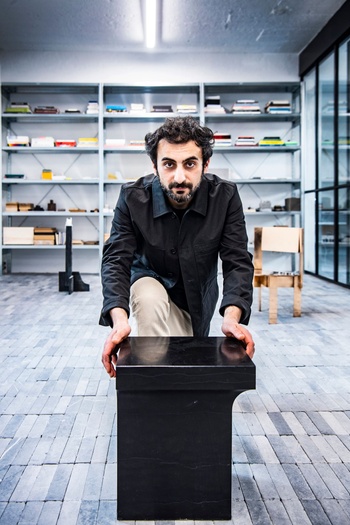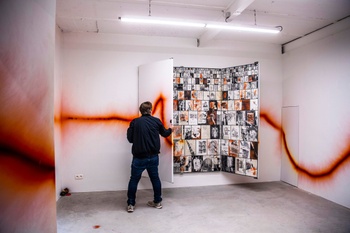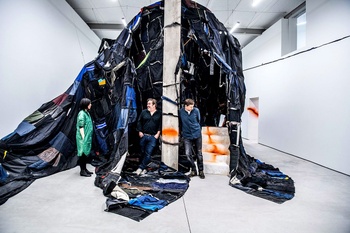A cathedral of human energy, sweat and worn sports jackets arises in HLP 1080, the new gallery that Harlan Levey and his partner Winnie Kwok have just opened in Molenbeek. Together with their friend, architectural, object and furniture designer Noro Khachatryan, they are redreaming the city's perceived heart of darkness.
© Saskia Vanderstichele
| From left to right: gallery owners Winnie Kwok and Harlan Levey, and artist Marcin Dudek in HLP 1080
In September 2010, in the context of Festival Kanal, Emilio López-Menchero and Souleimane Benaisa set up their version of Berlin's Checkpoint Charlie on Vlaamsepoort/Porte de Flandre. The duo, dressed up in military police uniforms, would stop any car wanting to cross the border between the popular, highly fashionable Dansaert neighbourhood and Gentsesteenweg/Chaussée de Gand, the asphalt artery leading into Molenbeek. It was a playful and critical way to question the invisible wall on that bridge, built on a lack of interest, social disparity, true crime, cultural misunderstandings, a difficult reputation and easy prejudice.
Eleven years after that public intervention a lot has changed and a fair amount hasn't. Reputation and prejudice are hard to shake off, and the 2016 terror attack at the Maalbeek/Maelbeek metro station hasn't helped to heal either of them. At the same time, a number of old and new cultural players have ensured that the one tangible bridge has turned into a multitude of enlightened paths into Brussels's perceived heart of darkness. From LaVallée to the MIMA, from iMAL to Needcompany, and from Recyclart to Decoratelier.
While it is a sad thing for the municipality that the canal has been a border for such a long time, it also provides opportunity here. Molenbeek is a place full of empty and cheap things to reinvent, to redream
“There is a rich tradition of cultural activities in Molenbeek,” says gallerist Harlan Levey, who, together with his partner Winnie Kwok, has just opened a second space, HLP 1080, on rue Isidore Teirlinck, a stone's throw from the house on Rue des Quatre Vents where terror suspect Salah Abdeslam was arrested after a shootout with the police. “You have Wim Vandekeybus's dance company Ultima Vez, Charleroi Danse/La Raffinerie, Vaartkapoen, the Philippe Vandenberg Foundation, located in the artist's former studio… Now Recyclart has moved to the Manchester site, and even HISK, the Higher Institute for Fine Arts in Ghent, has opened a base in the former Gosset factory. So you're entering an area that has a very rich tradition of experimental arts and important pioneers.”
“There are several reasons why all of these projects end up in Molenbeek,” Harlan Levey continues. “The kind of buildings that are ideal for these experimental practices, the kind everyone is looking for, are often found in Molenbeek. While it is a sad thing for the municipality that the canal has been a border for such a long time, it also provides opportunity here. This is a place full of empty and cheap things to reinvent, to redream. Also, despite this weird idea of Molenbeek being so far away, and being something other, its own territory, it is at spitting distance from the centre of Brussels. I think that the more people dream their dream over here and the more things happen, the sooner that checkpoint will vanish.”
NO SWEAT, NO GLORY
The space that Harlan Levey reinvented in Molenbeek is a typically Brussels surprise. You can't tell from the façade that behind the door, along a narrow corridor, you end up in a courtyard from which you immediately look inside a enormous, kunsthalle-like space. The former warehouse of 440 square meters, that also used to house a temporary mosque, has been magnificently refurbished by Noro Khachatryan, an architectural, object and furniture designer who has teamed up with Harlan Levey and Winnie Kwok and now has his studio and showroom on the second floor.

© Saskia Vanderstichele
| Noro Khachatryan in his studio/showroom, just above HLP 1080.
“It was a long trajectory,” Noro Khachatryan says on the eve of the official opening on Thursday 22 April, in between calls and visits from his family. “We only stopped building on Monday, after eighteen months of hard work. You go home for the night, and the day after, all of a sudden, you're using the space. I still need to adjust to that shift.” (Laughs) “We're all having a hard time to digest,” Harlan Levey agrees. “We have been working sixteen-hour days for months now. These last few weeks we had 25 people moving around the place, working on the building, putting up the show… I stand here now, and I love to be here, but besides a little bit of pride and a little bit of fear, it's hard to feel anything right now.”
You can almost feel how this dynamic has seeped into the floors and walls of the building. In the exhibition space, the enticing smell of something new mixes with sweat, as a twisted body made up of 230 cut up and reassembled sports jackets – “a cathedral of human energy”, Polish-born, Brussels-based artist Marcin Dudek calls it – arises from the floor. The exhibition “Slash & Burn II” is the latest episode in Marcin Dudek's overwhelming venture into his own biography, as a fan of the football club Cracovia and a former member of a hooligan gang. “Back in the 1990s, Poland and Eastern Europe were the West's dumping ground for used clothes and textile waste, and they still are. I carefully selected these jackets, had them torn up and sewn together again by Sew for Life – a Brussels organisation, that works with refugees and was founded by someone Winnie got to know when HLP was still a project space in the city centre – as a monstruous installation returning to where it came from.”
SCAR TISSUE
It's not hard to see the symbolism of that textile body, if you take away the violence and power of the number. Just as it is a way for hooligans to have and express an identity and at the same time disappear in the crowd, as an inaugural piece of this new space, it could stand for the protection and warmth of the family Marcin Dudek is now part of. The family that has been of such importance in his practice of forever questioning, creating and destroying, cutting up and remembering, reassembling and killing. “Ideas tend to become fixated, they're almost totalitarian that way. That's why I reject them immediately and move on to questions. Questions put you on the pedestal of creation. That's why I feel such restlessness in that vacuum after I finish a work. That's why I lit a smoke grenade and intervened in the space, created this thread of gentle destruction on the walls.”
It was a long trajectory. We only stopped building on Monday, after eighteen months of hard work. You go home for the night, and the day after, all of a sudden, you're using the space. I still need to adjust to that shift
The orange scar – the colour being a reference to the orange-coated bomberjacks Marcin Dudek used to wear inside out – as a thread to a common past, a way for the body to remember. “When we started out, back in 2011 on Rue Léon Lepage, we were still a project space,” says Harlan Levey. “You could count on us for looking at your ideas, going through the material, talking it through, helping improve, finding solutions, translating it into text or image…but not selling and making money. That only came over time. And even now, we stay involved in other projects to be able to remain independent from the market. We were just into the artists and, together with them, we grew into a business.”
That basis of kinship also becomes apparent in the fact that artist Emmanuel Van der Auwera, another part of the gallery's DNA, has his studio in the front building. “And then you have Sean Crossley's studio 500 meters from here and Marcin's studio just around the corner. We tend to work with a lot of artists who are based in Brussels. People have been boasting about the Brussels artistic scene, its diversity in backgrounds and stories and practices for quite a while now. So why wouldn't you be picking from this wonderful pool that is here with you?”

© Saskia Vanderstichele
| Marcin Dudek left a thread of gentle destruction on the new walls of HLP 1080
“You know, we are all immigrants to this city,” Harlan Levey, who came to the Low Countries as an aspiring professional football player, continues. I dream up metaphors of ephemeral cities, of people moving through time and space, of energies continually appearing and disappearing, of an artist resisting fixed ideas... He means it literally: “Noro was born in Armenia, Winnie is from Hong Kong, I'm from Cleveland, Ohio – but at the same time, we have been part of the fabric here for so long. You're not gonna find another gallerist that set up their first projects at Mr Ego on Steenstraat/Rue des Pierres, worked at Cinema Nova, washed dishes at the Walvis, bartended at the DNA and wrote for the Beursschouwburg and Etcetera. Winnie has been through the design academies, done projects for UNRIC (United Nations Regional Information Centre), the city and the European network Glass Is Tomorrow, and has been building this HLP project with me every bit since the start, and Noro has been forever doing meetings in the cafes of the city.”
A HEALTHY DOSE OF SERENDIPITY
“I have been sleeping in Mechelen, where I live, and working in Brussels for as long as I have been a designer,” Noro Khachatryan confirms. “This physical space, to work and to live in, finally makes it official.”
People have been boasting about the Brussels artistic scene, its diversity in backgrounds and stories and practices for quite a while now. So why wouldn't you be picking from this wonderful pool that is here with you?
“We have never been able to stand for culture,” Harlan Levey adds, referring to Still Standing for Culture, the collective that pleads for the reopening of the culture sector. “It's been running, scratching, sweating, fighting, dancing, screaming all the way. But we have definitely also had a good healthy dose of serendipity.”
“In meeting Noro back in 2008, at a Belgian design event in Saint-Étienne, giving way to this very organic and highly complementary exchange of Harlan and me writing and presenting his work, and Noro designing fair furniture for us for example,” Winnie Kwok adds. “But also in finding this amazing building that wasn't even on the market. This addition to our Ixelles-based gallery – called HLP 1050 – has been a dream for a long time. We knew that if we had a permanent space, and were not at the mercy of the unpredictable rental market like in Hong Kong and New York, we would be able to grow the business. After years of living rock 'n' roll, putting all our money back into the business, this sustainable future, for ourselves and for our artists, is what we want.”
DREAM TEAM
“It allows us to dream,” Harlan Levey agrees. “Who knows what the next step will be? I would like to have a small place in the US, maybe Dallas or Cleveland, or even another one in Belgium. I don't think this stops here. I hope not. But first let's open this space. The real work still needs to be done. We will have to assimilate our practice in a neighbourhood that has nothing similar, that maybe hasn't seen things like this around. How will we keep our character while these new surroundings seep in? What will the neighbourhood do to our curatorial approach? I'm curious to find out.”

© Saskia Vanderstichele
“You know, these past few months have been such a warming and rewarding experience,” says Winnie Kwok, when I say goodbye at the front door. Art has retreated behind its unsuspecting façade again and out on the street life picks up where I left off. “Our neighbours have been so friendly and I have the feeling this has all brought us even closer together than we already were. Maybe it's due to Harlan's football past. (Laughs) This is a team, you know.” A body running, scratching, sweating, fighting, dancing, screaming its way to a glorious future.
MARCIN DUDEK: SLASH & BURN II
> 31/7 (by appointment), HLP 1080, hl-projects.com
Read more about: Expo